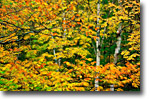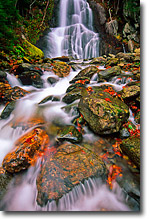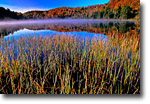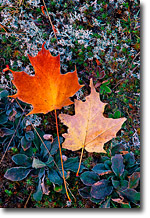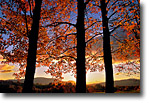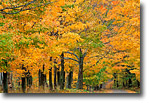It’s no secret that New England has some of the finest autumn color in the United States. Every year, hundreds of photographers flock to the mountains and coastlines of New England in search of fiery tapestries and iconic landscapes. While all of New England, from the rocky shores of Acadia National Park to the soaring and windswept Presidential Range in New Hampshire’s White Mountains, offers countless photographic opportunities, there is no other place than Vermont that I would rather be.
Vermont holds many treasures for the nature and travel photographer, from the rugged Appalachian Mountains, quaint villages, roaring waterfalls, thousands of miles of streams and rivers, scenic overlooks, lonely dirt roads and rustic barns. You could spend a lifetime of shooting in Vermont and only begin to unlock her many secrets and photographic potential. Autumn in Vermont begins in the last week of September up in the Northeast Kingdom and usually winds down around the second or third week of October in the southern part of the state. If you have the time and resources, you could spend roughly three to four weeks shooting autumn color in the state alone! While most of us don’t have unlimited time to spend an entire month exploring the state, a few days or a week will do you well in capturing some magnificent autumn images. Let me share with you a few of my favorite spots and techniques for creating stunning autumn images in Vermont.
The Northeast Kingdom
Located in the northeast region of the state and bordered by Canada to the north and New Hampshire to the east, the Northeast Kingdom has long been cherished for its spectacular
|
Duck Pond is a wonderful sunrise location located 6 miles north of Sheffield, Vermont. Duck Pond is gorgeous, bordered by cattails and surrounded by mountains of fiery color. From Sheffield travel north on VT-122 for 2 miles and then turn right on Old Duck Pond Road and follow until you hit the pond.
Lake Willoughby is an iconic spot with the peaks of Mount Hor and Mount Pisgah on both sides. This is definitely a great place at sunset or sunrise and on a calm evening can yield some amazing reflections. You will want to have a wide angle and telephoto lens for this location. A set of graduated neutral density filters will help reduce the light values in the sky at sunrise and sunset. As always, a polarizer will certainly be a great help in darkening the sky and allowing any clouds in the sky to pop out. From the town of Lyndonville, head north on E. Burke road towards the quaint village of East Burke. This area is a great sunrise shoot and offers some amazing shots along the way. You will be able to line up images of rustic barns, winding country roads, and pastoral autumn landscapes. From East Burke, continue north towards Island Pond and Brighton State Forest. Island Pond is a great sunrise or sunset location. In the evening, position yourself along the south end of Island Pond to frame Bluff Mountain bathed in warm afternoon light and reflected in the pond's still, glassy water.
On a wet and overcast day, don’t stay indoors but rather get out and drive as many back roads as possible. There are countless photo ops and the soft even light will allow you to shoot all day long. Take as many country roads as possible and you are sure to find countless streams, forest scenes, old barns, twisting roads and rugged mountains.
Smugglers Notch and Mount Mansfield
Smugglers Notch and Mount Mansfield are probably the most visited natural locations in Vermont and for good reason. Smugglers Notch gets its name from Vermonters, who during the war of 1812, were prohibited from trading goods with Canada and used the natural notch to smuggle goods across the border. Today, Smugglers Notch is a year round outdoor playground with skiing in the winter and hiking and climbing during all four seasons.
For the less adventurous traveler, scenic road Rt.108 travels through the notch towards the summit of Mount Mansfield and offers countless roadside shots of pristine forests, rugged rock outcroppings, and views of the surrounding mountains. Visit the area on a weekday and in the morning before the crowds come out in full force. A telephoto and macro lens will be perfect for picking out beautiful sections of woods and composing intimate macro images of dew covered leaves and spider webs. From the town of Jericho, the view of Mount Mansfield is impressive and is great for a sunrise shoot.
For the more adventurous explorer, I highly recommend hiking the Mount Mansfield Traverse. This rugged trail will take you through the picturesque woods and up to the long trail where you will traverse open tundra to the “Chin” on Mount Mansfield’s summit. This is a great hike to do on an overcast day or later in the afternoon to be on the summit for a spectacular sunset. Please be aware if you stay to shoot sunset, you will be walking back in the dark and you should have a headlamp and topographical map with you. For more information on this hike please visit www.greenmountainclub.org.
The Green Mountain National Forest
Covering more than 100 miles from the Massachusetts border all the way to Appalachian Gap, the Green Mountains are filled with rugged peaks, cold streams, pristine forests, beaver ponds, the Appalachian Trail, moose, and countless narrow forest roads for scenic drives and roadside shooting. Route 100 is the main artery of discovery in the Greens and will get you to some of the best photo locations. I recommend either car camping or setting up base camp in one of the many National Forest campsites between Killington and Granville. If you don’t wish to spend your nights in a tent or the back of the truck, I recommend staying in Killington or a bed and breakfast along Rt. 100.
Moss Glen Falls is the most photogenic waterfall in the state of Vermont. Moss Glen Falls is located right of the side of Rt. 100 just 3 miles north of the town of Granville. You will definitely want to bring a wide-angle lens and polarizing filter. Just after a light rain or on an overcast day are the best conditions for shooting this iconic spot. Climb down into the stream for a great view looking up towards the falls and you can line up some great cascades in the foreground. Also, try to make your way across the road and line up the beautiful autumn foliage against the falls with your telephoto lens.
Texas Falls is located off Rt.125 and Texas Falls Road (State Forest Highway #39). This is an all-around great location for stream scenics, waterfalls, macro subjects, and forest shots. Make sure you come here on a damp overcast day and bring your circular polarizer to reduce glare from the wet vegetation and rocks. After the parking area for Texas Falls, the road continues for several miles following the brook and there are countless photo oportunities along the way.
The Natural Turnpike is a back road located of Rt. 125 near the town of Ripton. This is a great location to get into the backwoods and explore countless beaver ponds, pristine woods and small brooks. Clear mornings are great for sunrise light at the beaver ponds, but you will definitely want overcast or wet conditions for the remainder of the day. This area is full of great back roads to explore and you could easily spend an entire day in the vicinity exploring all of the photo opportunities.
The Great Cliff and Mount Horrid Trail located off Rt. 73 at Brandon Gap offers a great chance to line up mountains of autumn color at sunrise or sunset. From Rt. 100 take Rt.73 west until you reach Brandon Gap. You will find a parking area and access to the Long Trail. Follow the Long Trail north for .7 mile until you reach the Great Cliff. Bring your wide-angle lens for sweeping scenics and your telephoto to pluck out isolated shots of the autumn foliage and rolling mountains. A circular polarizer and set of graduated neutral density filters will be need at sunrise and sunset. As a side note, Rt. 73 has some really amazing opportunities for creating isolated scenics of the autumn woods along the drive and it is best on wet and overcast days.
Middlebury Gap off Rt. 125 is a great sunset location with beautiful views of the mountains of Vermont and New York. You can choose to shoot right off the road or walk along the Long Trail to Silent Cliff for solitude and a higher perspective.
Back roads of Vermont
There is nothing better than driving the rolling and seemingly endless back roads of New England in the fall. Just being able to get out in the car and drive to new places is exciting and very rewarding for great photographs.
In closing, remember that autumn color should be great somewhere in the state between the last week of September through he third week of October. Be sure to check the current foliage conditions before leaving for your trip to know the best section of the state in which to start. I highly recommend picking up DeLorme’s Vermont Atlas and Gazetteer, which is full of detailed maps, back roads, waterfalls, hiking trails, covered bridges, natural areas, and much more. When you find an area with great autumn foliage, try to work it to its maximum potential. Shoot it wide, do macro work, look for reflections, shoot isolated scenics of the woods and experiment with abstract photography.
Foliage Conditions:
http://www.foliagenetwork.com/default.php
http://www.foliage-vermont.com/fall_maps.htm
Comments on NPN nature and travel photography articles? Send them to the editor.
Joseph Rossbach is a professional landscape and nature photographer based out of Annapolis, Maryland. Over the past ten years, he has traveled into some of the most beautiful and remote areas of the United States in order to capture the American landscape. His images have appeared in local and regional magazines, calenders, advertising campaigns, websites and in books and art galleries and corporate collections. He is a Mountain Trail Photo team member and leads through Mountain Trail Photography Workshops. To see more of Joseph's images visit his website at www.josephrossbach.com.
